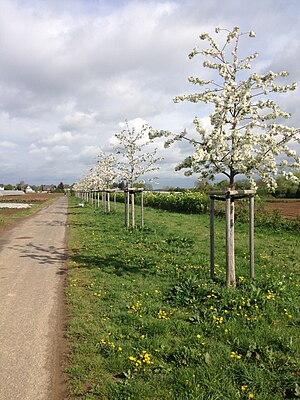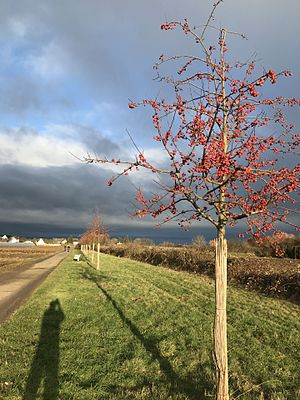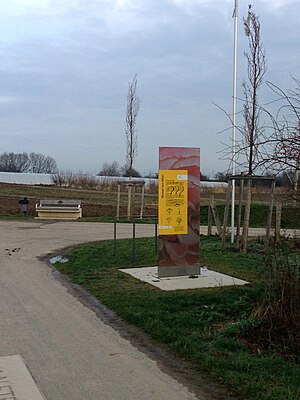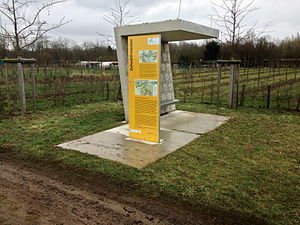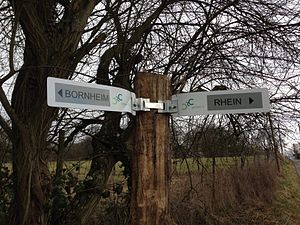Green C
The Green C is a landscape project as part of the Regionale 2010 in the Cologne - Bonn conurbation . The name refers to the shape of the area from the initial phase of the project.
The area extends from the Ville over the Rhine to the Siegtal and from there to the Siebengebirge ; a landscape that connects the Rhineland Nature Park in the west with the Siebengebirge Nature Park in the east and consists of many different elements. It is part of a large-scale network of green belts and landscape corridors that is to be developed as a cultural landscape network as part of the so-called “Green Masterplan” . The project is funded by the Federal Ministry of Transport, Building and Urban Development , the State of North Rhine-Westphalia and the European Union .
The framework for the area is formed by Bonn, Alfter and Bornheim on the left bank of the Rhine and Niederkassel , Troisdorf and Sankt Augustin on the right . The six cities and the Rhein-Sieg district have the common goal of protecting the relevant landscape, limiting the expansion of the settlement areas into the cultural landscape and securing the surrounding open spaces.
The landscape spaces
The Green C can be divided into nine different landscapes:
- the " Meßdorfer Feld " in Bonn
- the "garden land" between Alfter, Bonn and Bornheim
- the " foothills "
- the "gravel landscape" in Bornheim
- the "Rheinaue" in Niederkassel
- the " Siegaue " in Troisdorf
- the " Hangelarer Heide "
- the "Birlinghovener Forest"
- the " Pleisbachtal " in Sankt Augustin.
The four landscape areas on the left bank of the Rhine are dominated by agriculture: the Meßdorfer Feld, the garden area, the foothills and the gravel landscape.
The four areas on the right bank of the Rhine are much more determined by meadows and floodplains: the Siegaue, the Hangelarer Heide, the Birlinghover Forest and the Pleisbachtal.
The ninth room - located in the center - is the Rhine with immediately adjacent floodplain areas.
With the green C , a continuous path connection is created, also referred to here as a "link", which connects the different landscape areas with one another. A kind of park of cultural landscapes is to be created with the aim of increasing the recreational use of the area and protecting nature in all its diversity.
In total, the rooms cover an area of 37 km 2 .
The master plan and the key project "Mondorf Ferry"
There is a master plan for the design of Green C , which includes the entire area, as well as many partial plans for individual locations. Some projects have already been implemented or are currently under construction, above all the two bank areas of the moorings of the Mondorf ferry. This is the key project for the Green C , as it symbolizes the building of a bridge over the Rhine and enables a continuous path connection through the landscape.
The second important element is the expansion and completion of the existing paths to create a continuous hiking and cycling route from the Ville to the Siebengebirge. This system of paths, the “Link”, connects the different landscape spaces and links them to a park of landscapes.
Other important building blocks of the project are the so-called “gates”, designed transitions between landscape and city - and the “stations”: special places with individual design.
The link
The "Link" - a system of paths through Green C - connects the three landscapes of the Rhineland Nature Park in the west, the Siebengebirge Nature Park in the southeast and the Siegaue nature reserve .
The path system begins on the Rhine at the moorings of the Mondorf ferry and extends “root-like” into the landscapes on the left and right of the Rhine. The link runs mainly on existing paths that are partially expanded and renewed. The link is about 61 kilometers long.
The elements of the link
The link integrates different elements. These should on the one hand make the course of the link recognizable, on the other hand provide information about the project and the environment.
Accompanying rows of trees
The link as a system of paths through Green C should be accompanied by rows of trees with tree species typical of the area (e.g. willows or poplars ).
Gates with information boards
Differently designed "tree gates" and information boards placed on them should clarify the access to settlement areas and the entrances to Green C. The tree gates are provided in four different sizes. The boards contain information about the neighboring place and the surrounding landscape.
Kilometrage
The kilometering of the link begins on the Rhine (kilometer 0) in the area of the Mondorf ferry. From there, every additional kilometer of the link, which extends to the left and right of the Rhine into the surrounding landscape, is marked in the surface covering.
Marking elements
Two marking elements are inserted in front of and behind each intersection. The direction of the route leading to the Rhine is marked with the inscription "Rhine", the opposite marking indicates the name of the nearest place with an inscription.
Stations
Stations are planned at irregular intervals along the link. There are partially covered seating. An information board is attached to each station, which on the one hand presents general information on the landscape and on the other hand on special features of the immediate surroundings. Some parts of the landscape in Green C are worth looking at from a higher point of view. The raised stand developed for this purpose offers an overview or the opportunity to observe nature, on the other hand, like the accompanying row of trees, it also represents a widely visible marking of the link.
The individual projects
In the municipalities of Alfter, Bonn, Bornheim, Niederkassel, Sankt Augustin and Troisdorf, various individual projects are being implemented within the framework of Green C. The municipalities involved, the Federal Ministry for Transport, Building and Urban Development, the State of North Rhine-Westphalia and the European Union have formulated a so-called “Green Master Plan”; The following individual measures are based on this set of rules:
- the "Green Center" in Sankt Augustin
- the “Generations Parcours” in Sankt Augustin
- the "Gardens of Nations" in Sankt Augustin
- the "Siegauen-Wanderparkplatz" in Troisdorf
- the "fish trail" in Troisdorf
- the "Renaturation Rheidter Werth" in Niederkassel
- the "Mondorfer Ferry" in Niederkassel and Bonn
- the "Villa Rustica" in Bornheim
- the “Buschdorf-Rosenfeld green corridor” in Bonn
criticism
The total costs of € 18.6 million, but also the design of the Green C , in particular the signposting of the paths, met with heavy criticism from parts of the population and also from some politicians. After the direction arrows sometimes pointed in the wrong direction, improvements were made. The administration is of the opinion that the planning language on which the Green C is based does not always appear transparent and understandable to the citizen using it. Vandalism is a general problem for the new facilities. There is also resistance to the installation of the stations and elevated stands . Despite the high cost, z. For example, the quality of the flags used on the elements is so bad that after a year only "scraps" are dangling everywhere. The flagpoles were largely dismantled in 2015. The lack of accessibility continues to be criticized.
The criticism of residents and long-term users of the public spaces was expressed in numerous letters to the editor, especially during the construction phase. Finally, denounced the Black Book of the taxpayers the Green C than control wastage of what led to supra-regional attention. In Extra 3 of February 11, 2015 and the show Mario Barth reveals! From November 19, 2014, short reports on the project were shown.
After completion of the project and submission of the evaluation report, the actors from politics and administration see the project as a success and “example of successful inter-municipal cooperation”. However, they admit deficiencies in the public relations and communication work of the municipalities involved, which means that the public does not see “the real achievements, such as securing open spaces”.
The BUND criticizes that the protection category landscape protection is by far not sufficient to prevent progressive development of the C-area, which is located in a heavily populated area, as a biotope network . Individual construction projects have already been approved. In order to do justice to the project goal of "protection of open spaces ", the area should be placed under nature protection.
The KlimaExpo.NRW, an initiative of the North Rhine-Westphalian state government for innovation, education and climate protection, has recognized the Green C project as a pioneer in climate protection.
Web links
- Website of the Green C
- The “Green C” pilot project of the Regionale 2010. In: Urban planning: Tasks and projects. City of Bonn, August 14, 2012, archived from the original on October 24, 2013 ; accessed on January 27, 2014 .
Individual evidence
- ↑ Klaus Bouchon: Das Grüne C. An intermunicipal regional project to secure open spaces on the periphery of the city of Bonn. In: Stadt und Grün / Das Gartenamt. 2010, pp. 20–25 , accessed on January 24, 2014 (link only refers to the possibility of ordering in paper form, no pdf available).
- ↑ Das Grüne C. Securing the natural and cultural space in our region. City of Troisdorf, accessed on January 24, 2014 .
- ↑ a b Norbert Kloeters, Heinz Rohn, 3 + FREIRAUMPLANER, Aachen: Project dossier Green C. (PDF; 4.2 MB) Pilot of the master plan: green. Regional 2010 Agency, June 2007, pp. 23–35 , accessed on January 24, 2014 .
- ^ Mondorf ferry. In Niederkassel and Bonn. City of Troisdorf, accessed on January 24, 2014 .
- ↑ a b The link. A path that connects. City of Troisdorf, accessed on January 24, 2014 .
- ↑ Ilse Mohr: Alfter's contributions to the “Green C” are ready. Local history on the object. In: General-Anzeiger (Bonn). October 23, 2013, accessed January 27, 2014 .
- ↑ Hannah Schmitt: "Green C" is taking shape. Working in Bornheim. In: General-Anzeiger (Bonn). March 8, 2014, accessed March 8, 2014 .
- ↑ Projects. Special sights of the green C. Stadt Troisdorf, accessed on January 24, 2014 .
- ↑ Green C. (PDF) Evaluation of the project. Federal City of Bonn - Office for Urban Greenery, March 13, 2015, p. 3 , accessed on September 22, 2015 (short version).
- ↑ Hans-Peter Fuß: Costs for “Green C” are many times higher. In: General-Anzeiger (Bonn). October 13, 2011, accessed January 27, 2014 .
- ^ Rolf Kleinfeld: 34,000 euros for a concrete shelter. In: General-Anzeiger (Bonn). February 3, 2014, accessed February 3, 2014 .
- ↑ Johanna Heinz: "There's money for such nonsense". In: General-Anzeiger (Bonn). February 15, 2014, accessed February 20, 2014 .
- ↑ Rolf Kleinfeld: City puts the cost of the signpost at 153,000 euros. Meßdorfer field. In: General-Anzeiger (Bonn). January 29, 2014, accessed January 29, 2014 .
- ↑ Martin Ochmann: Bonner Greens criticize Green C. In: General-Anzeiger (Bonn). November 20, 2013, accessed January 24, 2014 .
- ↑ Rolf Kleinfeld: Directional arrows lead astray. New signposts. In: General-Anzeiger (Bonn). November 15, 2013, accessed January 24, 2014 .
- ↑ Rolf Kleinfeld: Smaller mistakes are corrected. In: General-Anzeiger (Bonn). November 26, 2013, accessed January 24, 2014 .
- ↑ Michael Lehnberg: Arrows for cyclists point in the wrong direction. Improvements for "Green C". In: General-Anzeiger (Bonn). November 30, 2013, accessed January 27, 2014 .
- ↑ Rolf Kleinfeld: Black Ribbon and Fantasy Signs. In: General-Anzeiger (Bonn). December 13, 2013, accessed January 24, 2014 .
- ↑ Holger Willcke: Vandalism on the Meßdorfer field. In: General-Anzeiger (Bonn). May 9, 2012, accessed January 24, 2014 .
- ^ Rolf Kleinfeld: No majority for the "station" in the Meßdorfer Feld. In: General-Anzeiger (Bonn). February 20, 2014, accessed February 20, 2014 .
- ^ Rolf Kleinfeld: For hunters? The high stand of Lessenich. In: General-Anzeiger (Bonn). February 10, 2014, accessed February 20, 2014 .
- ↑ Martina Welt: Seen this way: Gone with the wind. In: General-Anzeiger (Bonn). February 24, 2014, accessed March 8, 2014 .
- ^ Bettina Thränhardt: Green C in Alfter and Bornheim. The concept remains a mystery. In: General-Anzeiger (Bonn). April 21, 2015, accessed April 21, 2015 .
- ↑ Barbara Hardinghaus: Foresight. A message and its story: Why a viewing platform near Cologne is not a laughing stock . In: Der Spiegel . No. 16 , 2014, p. 51 ( online - April 19, 2014 ).
- ^ Wilfried Goebels and Michael Lehnberg: Black Book of the NRW Taxpayers Association. Unrestrained waste. In: General-Anzeiger (Bonn). October 8, 2014, accessed October 9, 2014 .
- ↑ Daniel Sprenger: Realer Madness: The green C. In: NDR etra February 3 , 2015, accessed on September 22, 2015 .
- ↑ Cem Akalin: Evaluation report on the Green C. “Goal achieved, freedom secured”. In: General-Anzeiger (Bonn). March 21, 2015, accessed March 22, 2015 .
- ↑ Cem Akalin: Criticism must be allowed. In: General-Anzeiger (Bonn). March 21, 2015, accessed March 22, 2015 .
- ↑ Michael Lehnberg: Demands of the BUND. Nature conservation for the "Green C". In: General-Anzeiger (Bonn). April 9, 2015, accessed September 22, 2015 .
- ↑ Green C awarded for climate protection. Retrieved October 2, 2015.












